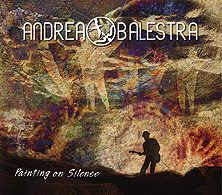 Although
he grew up listening to Hendrix, Santana and The Beatles, L.A. based
Andrea Balestra is primarily a jazz-rock / instrumental music
guitar player. Andrea's 2010 Fine Arts Avenue turned heads
around and he carries his sound forward with the 2013 CD release of
Painting On Silence. Full of high-powered guitar-centric
instrumentals, the 9 track CD features Andrea in the studio with fine
players including drummer Dario Benzoni and co-producer Dave
Hill. Cut live in the studio there’s an electric energy on
hand here. Several guitar legends guest, assisting Andrea, and appear
on various tracks including Carl Verheyen, Julien Kasper,
Scott Henderson, John Pisano and Steve Trovato.
The songs are more than up to the test and a funky, jazzy instrumental
fusion cover here of the Beatles’ Abbey Road classic “Come
Together” featuring Andrea and his band, including Carl Verheyen,
bestowes a new and innovative shine on a timeless classic. Also covered
is the Thelonius Monk favorite “Round Midnight”, featuring
Andrea and group with guitarist Steve Trovato. In addition to writing
the music, excepting the Beatles and Monk covers, Andrea has also
done a fine job on the mixing and mastering of the album, complimented
by excellent CD mastering by Gary Lurssen. Guitar fusion fans
will want to hear the smokin’ and very appealing sound of Painting
On Silence by Andrea Balestra. www.AndreaBalestra.com
Although
he grew up listening to Hendrix, Santana and The Beatles, L.A. based
Andrea Balestra is primarily a jazz-rock / instrumental music
guitar player. Andrea's 2010 Fine Arts Avenue turned heads
around and he carries his sound forward with the 2013 CD release of
Painting On Silence. Full of high-powered guitar-centric
instrumentals, the 9 track CD features Andrea in the studio with fine
players including drummer Dario Benzoni and co-producer Dave
Hill. Cut live in the studio there’s an electric energy on
hand here. Several guitar legends guest, assisting Andrea, and appear
on various tracks including Carl Verheyen, Julien Kasper,
Scott Henderson, John Pisano and Steve Trovato.
The songs are more than up to the test and a funky, jazzy instrumental
fusion cover here of the Beatles’ Abbey Road classic “Come
Together” featuring Andrea and his band, including Carl Verheyen,
bestowes a new and innovative shine on a timeless classic. Also covered
is the Thelonius Monk favorite “Round Midnight”, featuring
Andrea and group with guitarist Steve Trovato. In addition to writing
the music, excepting the Beatles and Monk covers, Andrea has also
done a fine job on the mixing and mastering of the album, complimented
by excellent CD mastering by Gary Lurssen. Guitar fusion fans
will want to hear the smokin’ and very appealing sound of Painting
On Silence by Andrea Balestra. www.AndreaBalestra.com
mwe3.com presents an interview
with
ANDREA BALESTRA
mwe3: What’s the inside story behind the making of Painting
On Silence and when was the music written and recorded and what
were some of your musical goals with this new album?
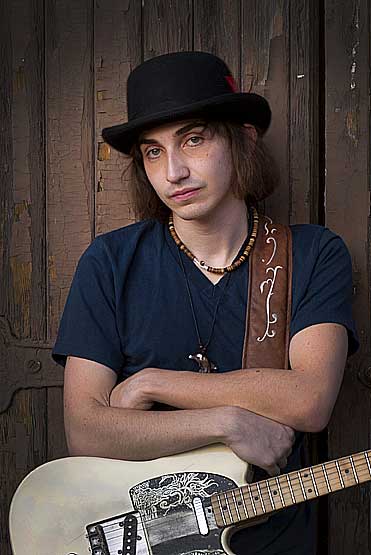 ANDREA
BALESTRA: I wrote the music in August of 2012 and then kept making
minor changes until the album was recorded in the Winter. I guess
the musical goal was to make a type of music that happened in the
moment.
ANDREA
BALESTRA: I wrote the music in August of 2012 and then kept making
minor changes until the album was recorded in the Winter. I guess
the musical goal was to make a type of music that happened in the
moment.
Right now I hear a lot of records that are made with guys sending
tracks over to each other, fake drums, people playing to backing tracks,
knowing every single note they'll play beforehand. There is nothing
wrong with recording music like that of course, but I really did miss
the whole "three guys in a room" feel to making music.
I mean, it's so great to listen to each other and not know where it's
gonna go and be glad it's far from perfect because that's not the
point. The point is take risks for your audience, do something you
won't repeat the same way ever again.
mwe3: The last album you made before this one, Fine Arts
Avenue was excellent as well so how was making Painting On
Silence different for you this time, both musically, compositionally
and recording wise?
ANDREA BALESTRA: For the first album I wanted it to be unpredictable
in the sense that "anything" could happen production wise
or stylistically, the inspiration then came from a naiff sculpture
so I wanted to make music that would be a rendition of that style.
In this second release I wanted to have a consistent production and
have no restraints as far as where the execution was gonna go. No
arrangements were planned before the sessions, no parts, sometimes
even chords were subject to change last minute. I must say it was
a lot more fun like this.
mwe3: Painting On Silence features a cover of the Beatles'
classic “Come Together” done instrumentally. What was it
about that song that made you want to reinterpret it as a cover, what
was your approach and who plays with you on that track? Would you
say that’s an example of your rock influences coming into the
picture and are there other vocal songs you’d like to rebuild
as fusion guitar instrumentals?
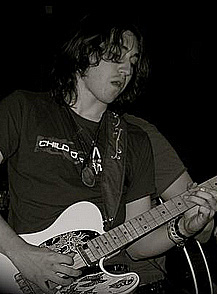 ANDREA
BALESTRA: I always loved the Beatles very much, it was the first
band I was really into when I was a child. I've been jamming it for
a while, it usually happened when I'd be playing a set and ran out
of songs, every time I called it it would work great even though the
band I'd be playing it with had never tried it before. I guess it
"agreed" very much with the concept of the album.
ANDREA
BALESTRA: I always loved the Beatles very much, it was the first
band I was really into when I was a child. I've been jamming it for
a while, it usually happened when I'd be playing a set and ran out
of songs, every time I called it it would work great even though the
band I'd be playing it with had never tried it before. I guess it
"agreed" very much with the concept of the album.
There's plenty of songs that I'd like to reinterpret, but I have to
take the time to see if I have a different angle on them. I wish I
could list some but there's just too much music I enjoy. I definitely
want to do some Ennio Morricone sooner or later.
On the track I'm accompanied by my trio with Dario Benzoni on drums
and Matias Alvear Fall on bass. The guest guitarist is Carl Verheyen.
I knew Carl is a really big Beatles fan as well, so I thought this
would be a great track to have him play on. His playing on it is simply
amazing as usual.
mwe3: There’s a number of guitar legends guesting on the
Painting On Silence CD besides Carl, including John Pisano,
Scott Henderson, Julien Kasper and Steve Trovato. How did you assemble
such a super group of musicians to once again appear on your CD while
also noting that several of these same players have worked with you
in the past. Can you say something these guitar legends who you worked
with on Painting On Silence, who are the other members of your
band and who else would you cite as being key to the album’s
sonic success?
ANDREA BALESTRA: There is a different story for how I got in
touch with every guitarist that guested on the album. I will say that
most of them are very good friends of mine, and that I can't be grateful
enough for their contribution to this record.
As soon as I decided to make an album that was focused on improvisation
I thought of bringing in fellow musicians whose improvisation I admired.
Each track has a different vibe to it and it's great to have different
players bring their personalities in the mix.
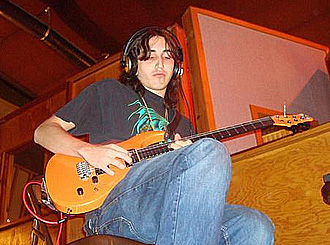 As
far as the rhythm section Dario and Matias are as good as it gets
for drums and bass. They're the type of players that truly believe
in listening and making things happen.
As
far as the rhythm section Dario and Matias are as good as it gets
for drums and bass. They're the type of players that truly believe
in listening and making things happen.
Of course I would like to mention Dave Hill for co-producing this
record and most importantly being a great friend in the making of
this album.
mwe3: What’s new and interesting in the guitar world for
you these days and are you still using the Telecaster guitars on the
new CD? Did you play any other guitars on the CD? What other guitars
do you enjoy playing and what other sound enhancing effects do you
use on the Painting On Silence CD?
ANDREA BALESTRA: Yes, I'm still using a Tele, I used an Eastman
semi-hollow on the title track and the opening and closing piece,
but when it comes to bluesy playing I decided to stick to a Telecaster.
I play a 335 just as much as the Tele nowadays... I like both guitars
because they have a strong trademark sound to them, everybody that
plays them doesn't sound like anybody else. On the record I just used
a distortion box straight into a Super Reverb Amp.
mwe3: How would you describe the chemistry between you and
co-producer Dave Hill and what in what ways did you work with Dave
on the various tracks and what was the studio environment like during
the recording process? Were most of the tracks cut live or was there
a lot of overdubbing and other studio wizardry, do you have a preference
and can you change the sound of a song with added or hidden tracks
to bring out the sonic flavors?
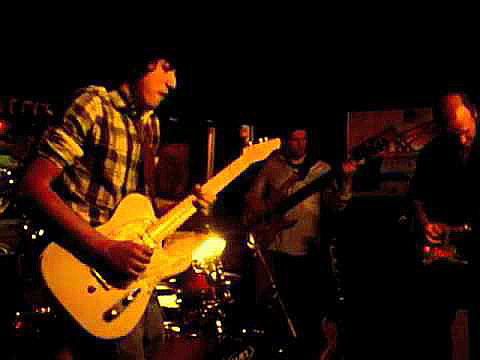 ANDREA
BALESTRA: Well again, a lot in this album was played by ear. When
I was looking for a place to record Dave asked me to stop by his place
to see how he did things. I really liked his philosophy because it
was all about vibe and getting the right tones and headphone mixes.
ANDREA
BALESTRA: Well again, a lot in this album was played by ear. When
I was looking for a place to record Dave asked me to stop by his place
to see how he did things. I really liked his philosophy because it
was all about vibe and getting the right tones and headphone mixes.
As we started to record he gave extremely valuable insight on every
song we were doing and all of a sudden I didn't feel like I was producing
by myself anymore. His help on the tracking was priceless.
All the tracks were cut live, the only exceptions were with Julien
Kasper and Scott Henderson as they overdubbed at their places on the
tracks we had cut live with the trio. A fact you should know as some
people have asked, the backwards guitar track on “Dark White
Skies” was done by Julien with a backwards delay, again, no digital
editing.
As far as giving the song its vibe rather than adding flavor I strip
things down to leave only what matters. I think it's easy to stack
things up but it's a lot harder to know what the song doesn't need
so that's what I strive to do when I produce music.
 mwe3:
I like the Leopold Stokowski quote from the Painting On Silence
CD packaging about how musicians paint their pictures on silence.
What do you feel did Stokwoski means with that quote? You were influenced
by a range of non-rock musicians and artists. There’s also a
quote from Jackson Pollock in the liner notes using the painting and
music comparison. How do you assimilate all of these amazing musical
and non musical influences into your sound?
mwe3:
I like the Leopold Stokowski quote from the Painting On Silence
CD packaging about how musicians paint their pictures on silence.
What do you feel did Stokwoski means with that quote? You were influenced
by a range of non-rock musicians and artists. There’s also a
quote from Jackson Pollock in the liner notes using the painting and
music comparison. How do you assimilate all of these amazing musical
and non musical influences into your sound?
ANDREA BALESTRA: Well it's all about seeing a bigger picture
I guess. As a musician it's easy to be stuck into music because I
dedicated my whole life to it. However, music is not the point of
music. I believe the goal of any artistic creation is in the emotion.
It's the same as a poem or a painting or even staring at the ocean
or anything else that grabs your heart.
Also I think the conception that you need some kind of background
in a certain field to appreciate a work of art is wrong. You can listen
to a sculpture or a painting just as you listen to music. The intention
the artist gave to it is in its entirety.
mwe3: What’s new in Los Angeles these days? It really
has proven to be a great town for jazz-rock music over the past 25
years and a lot of musicians still find their sound there. I remember
it back in the 1960s and ‘70s. What does L.A. represent to you
and how does living and working there influence your music even now?
 ANDREA
BALESTRA: There is definitely a lot in L.A., I think the club
scene took a blow after the recession... a lot of places shut down
and not that many opened up. However it is still the only place where
I can imagine seeing Albert Lee, Kirk Fletcher or John Pisano play
within the same week, free of charge.
ANDREA
BALESTRA: There is definitely a lot in L.A., I think the club
scene took a blow after the recession... a lot of places shut down
and not that many opened up. However it is still the only place where
I can imagine seeing Albert Lee, Kirk Fletcher or John Pisano play
within the same week, free of charge.
I love the fact that there are so many musicians here. It's definitely
a very vibrant environment. I think L.A. is very misinterpreted in
the sense that the image a lot of outsiders have of it is that everybody
here is trying to be a star.
If you pay attention to it though, there's plenty of artists here
and musicians that are very dedicated to their craft. We're just here
because there is a good industry to work with.
mwe3: How are you planning to get the word out about the Painting
On Silence CD and what are you planning among your next musical
moves including live shows, writing new music and recording in the
future?
ANDREA BALESTRA: I'm just going to use any channel that is
available, there's some of the videos of the recording sessions on
you tube and Facebook, then there is the press of course and there
are live shows.
As much as I'm active with "spreading the word", I don't
think that's the point. I believe in the quality of the music and
that always seems to find a way. Roy Buchanan was never famous yet
he influenced millions.
 I
think in this industry there is always a "middle man" getting
in the way. I think my music can be understood by anybody, it's extremely
accessible, yet if I brought it to someone on a label I would get
complaints that have nothing to do with the music. The only complaint
that was music related by somebody in the industry was that it didn't
sound like anything else, as if originality was a bad thing. Nowadays
people buy onto tours so maybe they can get in the position of getting
taken advantage by a record label.
I
think in this industry there is always a "middle man" getting
in the way. I think my music can be understood by anybody, it's extremely
accessible, yet if I brought it to someone on a label I would get
complaints that have nothing to do with the music. The only complaint
that was music related by somebody in the industry was that it didn't
sound like anything else, as if originality was a bad thing. Nowadays
people buy onto tours so maybe they can get in the position of getting
taken advantage by a record label.
I remember Zappa on Letterman saying that there was no way his record
would profit. If you don't compromise what you believe in as an artist
you're not gonna sell out either.
Thanks to Andrea Balestra @ www.AndreaBalestra.com



